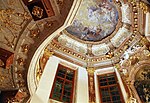Funeral Museum Vienna
1967 establishments in Austria20th-century architecture in AustriaArt museums and galleries in ViennaBuildings and structures in Simmering (Vienna)Death customs ... and 3 more
History museums in AustriaMuseums established in 1967Museums in Vienna

The Bestattungsmuseum Wien (English: "Funeral Museum Vienna") is a museum in Vienna, Austria. With around 1,000 exhibits, the Vienna Funeral Museum gives a comprehensive overview of funeral customs, burial rites, funerary art and the special Viennese perspective on death and provides information on the historical and current funeral services in Vienna.
Excerpt from the Wikipedia article Funeral Museum Vienna (License: CC BY-SA 3.0, Authors, Images).Funeral Museum Vienna
Goldeggasse, Vienna KG Wieden (Wieden)
Geographical coordinates (GPS) Address Nearby Places Show on map
Geographical coordinates (GPS)
| Latitude | Longitude |
|---|---|
| N 48.189707 ° | E 16.377021 ° |
Address
Goldeggasse 19
1040 Vienna, KG Wieden (Wieden)
Austria
Open on Google Maps










